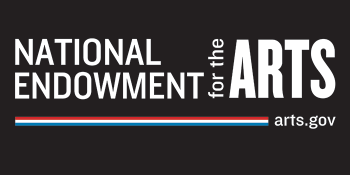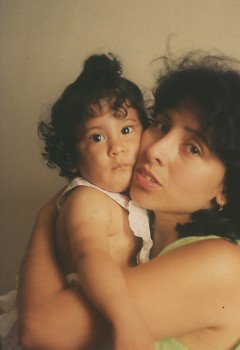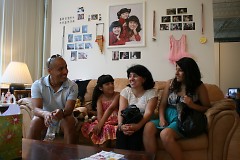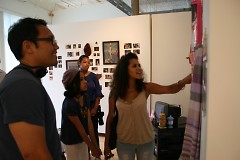Mandy Burrow, a local artist and art professor at Calvin College, seeks to foster an exchange between United States natives and immigrants in her current installation, "Americans." "Americans" invites viewers into the recreated living rooms of three Latino immigrant families.
The familiarity of the living spaces is striking: A well-worn couch, a TV and DVD player, family photos, Mr. Potato Head, high tops with pink shoe laces. Familiar and foreign artifacts meld in a way that challenges viewers to step outside of their experiences and into an immigrant’s dichotomous world. Burrow hopes the installation will encourage an exchange between viewers of the space and participating families, inviting outsiders in and insiders out.
The viewers begin the tour with the Rodriguez Family's living room. The Rodriguez Family—Etel, Antonio, and their three daughters—are from Peru. Peruvian artifacts, an alpaca backpack and a framed cut-out of the Virgin of Chapi accessorize the walls.
Viewers then make their way to the next Rodriguez family living room. Angel, originally from Puerto Rico, and Christina, a New York native, have five girls. Their living room is sprinkled with books in Spanish and English, references to the living dead, and a wooden plaque shaped like Puerto Rico that reads “Jehova es mi pastor” or “Jehovah is my Shepherd.”
Viewers end the tour with the Andrade-Nava living room. Oscar Andrade and Lulu Nava, from Mexico, have two children. Their walls boast an authentic sombrero and graduation certificates from the Pailalen Program, a parent training program. The mix of old and new, foreign and familiar, leaves viewers to ponder the ways in which they can relate to and learn from these families.
Burrow spent months building relationships with the three families while putting together the installation. She was connected to the families through mutual friends. Those friends acted as mediators, grounding Burrow's relationship for the first home visit and interview. During this visit, the families rummaged through their old photos and lent them to Burrow to examine and make her own prints for the show. Then, Burrow visited each family a second time to film the interviews that play on the televisions in each recreated living room.
“One of the things that struck me was how hard it can be to automatically be at a disadvantage," Burrow said. "For example, to have a college education from another country, and to come to the United States and be qualified to be a dishwasher seems ridiculous in some aspects. To hear families talk about the dad working a graveyard shift while the mother works an all-day shift and each one gets their daughter an hour or two a day, but then the rest of the time they’re either sleeping or working. That’s the cost of automatically being marginalized by a society.”
A second filming was conducted at both Rodriguezes' homes to interview the younger generations. Most of the younger generations were born in the United States, and Burrow used the second fliming to expose the differences between their parents’ experiences and their own.
Finally, Burrow visited the families to gather personal possessions for the installation. She felt a bit like an intruder at first, but the families were so eager to share their treasures that they proffered heirlooms such as valuable framed pictures and even encouraged her to go upstairs and dig around for herself.
With all the controversy around the issue of immigration, Burrow encourages the viewer to take a step back from immigration as a political issue and to look at it on the personal level and make a connection with the families.
”Those similarities can be found in our personal narratives, in our home lives, in our relationships. I am trying to foster a ground for common communication and understanding on the basis of our similarities,” Burrow expressed.
The living rooms create an intimacy—recognizable photos and worn couches are mainstays of many American homes—with the three immigrant families and ask viewers to understand that we are all Americans.
"Americans" opened on Saturday, June 5 with all three participating family members in attendance, and will run until Friday, July 9. The installation is located at the Calvin College (106) Gallery (106 S. Division).
The Rapidian, a program of the 501(c)3 nonprofit Community Media Center, relies on the community’s support to help cover the cost of training reporters and publishing content.
We need your help.
If each of our readers and content creators who values this community platform help support its creation and maintenance, The Rapidian can continue to educate and facilitate a conversation around issues for years to come.
Please support The Rapidian and make a contribution today.




Comments
Be sure to invite area Calvinist Vernon Ehlers, who likes setting up fences at the border and sending in the Minutemen to shoot Mexicans if needed ...
http://www.ontheissues.org/MI/Vernon_Ehlers_Immigration.htm
I saw the exhibit last evening! It was surprisingly inviting and intimate. So inviting, in fact, that my friend and I sat on the Navas' couch discussing our favorite cartoons growing up.
And we touched everything--the best type of exhibit! :)